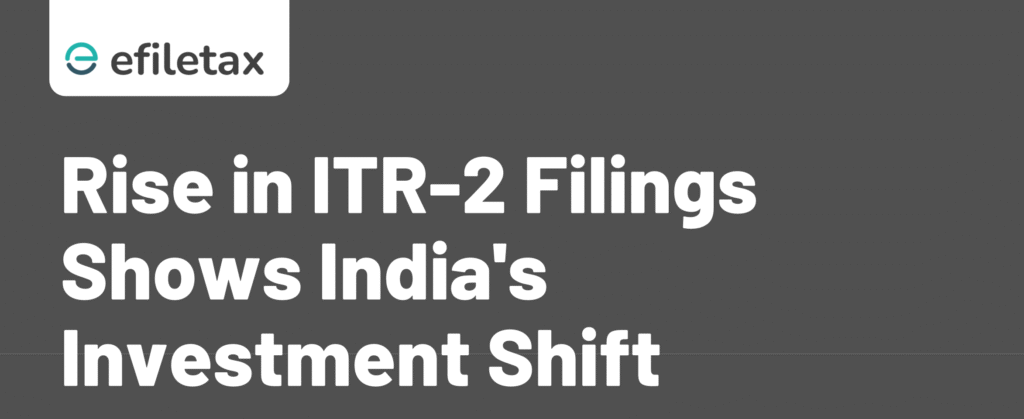
Why More Indians Are Filing ITR-2: A Post-Pandemic Shift
Rise in ITR-2 filings isn’t just a data point—it reflects a clear shift in how Indians earn and invest post-pandemic. From stocks and rental income to foreign investments and side hustles, salaried income is no longer the only taxable stream.
With tech-powered tax intelligence and new compliance tools like AIS and TIS, the Income Tax Department now tracks income across digital platforms, brokerages, and foreign banks. This blog breaks down why ITR-2 is gaining traction and what taxpayers need to know.
What Is ITR-2 and Who Should File It?
ITR-2 is for individuals and HUFs who:
- Earn income from salary/pension
- Have capital gains (stocks, mutual funds, property)
- Earn rental income from more than one house
- Have foreign income or foreign assets
- Hold directorship in a company or invest in unlisted shares
- Do not have income from business or profession (that’s ITR-3)
Key Drivers Behind the Rise in ITR-2 Filings
1. Stock Market Participation
- Zerodha, Groww, Upstox, and other brokers saw record new investors after 2020.
- Capital gains tax applies on sale of shares and mutual funds.
- With AIS showing stock sales, many must now shift from ITR-1 to ITR-2.
2. Real Estate Rentals and Multiple Properties
- Owning more than one property (even inherited) pushes you into ITR-2.
- Income from each house property must be declared separately.
3. Foreign Assets and Crypto
- Foreign bank accounts, shares, or property? You must disclose them in ITR-2.
- CBDT made foreign income reporting mandatory under Schedule FA.
4. Tech-Driven Tax Matching
- AIS and TIS match your Form 26AS, broker trades, dividends, and interest.
- Misreporting triggers compliance notices—especially under scrutiny after Budget 2023–24 tech initiatives.
5. Side Income After the Pandemic
- Freelancing, courses, digital gigs: Many salaried taxpayers also have other income now.
- Certain cases (e.g., royalty, dividends, gig work income) still fit ITR-2 if not under “profits & gains.”
CBDT Notifications and Compliance Triggers
| Notification | Impact |
|---|---|
| CBDT Notification No. 40/2025 | Updated ITR forms for AY 2025–26. Disclosures made more granular. |
| Budget 2024–25 | AIS/TIS integration deepened. Reporting standards tightened. |
| Section 139(1) | Mandatory return if TDS deducted or specified transactions crossed threshold. |
How to Know If You Need ITR-2
Here’s a quick checklist:
✅ Capital gains from mutual funds or shares
✅ More than one house property
✅ Foreign income or foreign assets
✅ Agriculture income above ₹5,000
✅ Director in a company or unlisted shareholding
✅ Income clubbing with spouse/minor
✅ Dividend income exceeding ₹10 lakh (liable to surcharge)
Expert Tip: Always Download AIS Before Filing
Before you start your ITR-2:
- Download AIS (Annual Information Statement) and TIS from https://www.incometax.gov.in
- Match it with your bank and broker statements
- Report all income, even if tax not deducted
- Use Form 10E if claiming salary arrears relief
Missing details or reporting income in ITR-1 instead of ITR-2 can lead to defective return notices (u/s 139(9)).
FAQs on ITR-2
Q1. Can salaried persons file ITR-2?
Yes, if they have capital gains, more than one house, or foreign income/assets.
Q2. Is ITR-2 applicable for crypto investors?
Yes, especially if crypto gains are reported as capital gains.
Q3. What if I hold shares in a private limited company?
You must disclose them in ITR-2, even if no dividend is received.
Conclusion: Report All Sources. File the Right Form.
The surge in ITR-2 filings signals a new era in taxpayer behavior—multi-income, investment-savvy, and tech-tracked. Misreporting or using the wrong ITR form can now raise red flags.
Need help filing your ITR-2 without errors?
Trust Efiletax to guide you with expert tax filing services.
Get started at www.efiletax.in
Summary
ITR-2 filings are rising as more Indians earn from stocks, property, and foreign assets. With tech-driven tax tracking, disclosing multiple income sources is now essential. Learn who should file ITR-2, why it matters, and how to stay compliant in the post-pandemic economy.